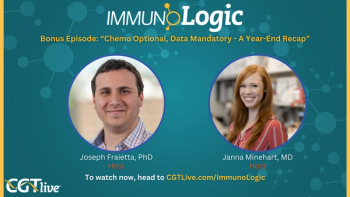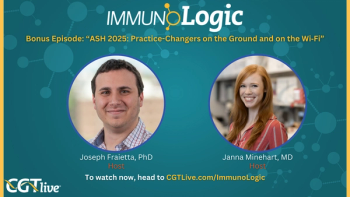
Challenges With Future Stem Cell Therapies in Parkinson Disease
Rajesh Pahwa, MD, FANA, FAAN, discussed balancing hope with current challenges with stem cell approaches in PD.
This content originally appeared on our sister site,
Parkinson disease (PD) is an area of growing investigations, with pipelines including a large variety of investigative approaches to treating the disease. Approaches such as gene therapy and cell therapy aim to treat unmet needs in the disease that a gold standard therapy like levodopa, although effective in relieving many symptoms, fail to address.
Rajesh Pahwa, MD, FANA, FAAN, discussed these emerging therapies at the 2022 Advanced Therapeutics in Movement and Related Disorders (ATMRD) Congress in Washington, DC, June 17-19. Pahwa discussed 4 specific therapies on the horizon that might be able to address, at least in part, some of the shortcomings of the available options. Pahwa, the Laverne and Joyce Rider Professor of Neurology; chief, Parkinson’s Disease and Movement Disorders Division; and director, Parkinson’s Foundation Center of Excellence, University of Kansas Medical Center, shared that IPX-203, apomorphine subcutaneous infusion, continuous foslevodopa/foscarbidopa infusion (also known as ABBV-591), and continuous subcutaneous liquid levodopa/carbidopa (also known as ND0612) could all enter the market within the next couple years.
“If I were to predict, I would say the next four of them would definitely be in the market in the next 3 to 4 years,” Pahwa said. “We have had levodopa which is the gold standard for the treatment of Parkinson disease. We have had different extended forms of levodopa—we had the sustained release carbidopa-levodopa that came out 30 years ago. We had the extended-release capsules that came out, about 4 to 5 years ago now. The next generation, so to speak, is IPX-203.”
The next therapy that will become available will likely be subcutaneous apomorphine infusion, closely followed by foslevodopa/foscarbidopa, and then IPX-203, Pahwa predicted. “The Neuroderm subcutaneous liquid levodopa [ND0612] will be another few years later. The rest of them—we do not know where they'll end up with phase 3 studies,” he said.
“The thing is, we still don't have that perfect carbidopa-levodopa where we can say ‘OK, we have reached the stage that this is the best one out there.’ But every extended-release formulation, we have made some degree of improvement over the past. The extended-release capsules were better than the sustained release because we could get immediate action. And the same thing, I think, with IPX-203. We will, hopefully, have a better improvement than we saw with the previous one,” he continued.
Pahwa turned to cell and gene therapy after discussing clinical data on subcutaneous apomorphine infusion, foslevodopa/foscarbidopa, and IPX-203. He touched on gene therapies that have been assessed—mostly unsuccessfully—in PD before turning to stem cell-based therapies. Although patients talk about the potential of stem cell approaches with hope, he shared that this approach can often come with difficulties, and the progress has been slow.
WATCH NOW:
“We are very early in the journey of stem cell therapies. The challenges with Parkinson are multiple. You have to figure out the source of this stem cell, the quality of stem cell, age of the patient, stage of the patient, surgical techniques used, the need to use immunosuppression therapy or not use immunosuppression therapy,” Pahwa explained. “We are looking at a lot of challenges that we have not completely eliminated when we talk about stem cells. But like I said, every patient really feels that the stem cell is going to be an answer to their Parkinson's disease. The challenge is, as far as being a clinician is that Parkinson's is a progressive disorder that affects multiple areas in the brain. Using stem cell therapy, can we stop this progression? Can we actually slow down the disease or cure it? Or is it really going to only focus on dopaminergic replacement? And I think those are our challenges.”
These challenges as well as the promises, he explained, can also be unique to each source of stem cells that is taken with this approach. For fetal ventral mesencephalic cells or embryonic stem cells, there are a few trials ongoing—the TRANSEURO (NCT01898390), STEM-PD (NCT02452723), and NYSTEM (NCT03119636), specifically—and there have been positives with these cells, including good long-term graft survival and their indefinite expandability. But they do carry ethical concerns and can be both unpredictable and limited in terms of their supply. Additionally, tissue rejection and tumorigenesis are possible risks.
Induced pluripotent stem cells are another approach in an ongoing trial at the Center for iPS Cell Research and Application, in Kyoto, Japan. These cells, similar to the aforementioned ones, also come with the benefit of indefinite expandability, and unlike the prior mentioned, have an easily accessible source and lack the need for immunosuppressive therapy. Although, they have a high operative cost, can be time consuming to develop, and require complex procedures.
The final option, neural progenitor cells, are also being assessed in two clinical trials (NCT03309514 and NCT01329926), and offer an easy expansion and differentiation protocol, as well as a large quantity source and multipotency. But, again, they carry risks such as low graft survivability and limited proliferation, and they require invasive tissue collection.
“People are surprised that we are so slow with stem cells,” Pahwa said. “Seven years ago, I used to say, ‘Oh, it's going to be 5 to 10 years,’ and everyone was led to believe that it was all the federal government’s fault that we were going so slow. But really, it takes a long time, looking at the safety of it, because all you need is one patient who have a significant complication, and this is going to be put on the backburner for a long time.”
Pahwa stressed the importance of being honest with patients about the progress being made in this area, given the significant interest from the general population in stem cell approaches. He warned about patients seeking out unapproved, unregulated treatment by either traveling out of the United States, or within.
“What I tell my patients is don't spend the money because a lot of people out there [are selling this idea], not only if you're talking about going to a different country, even in the US,” he said. “I have a patient who was walking and doing well, who had stem cells injected in her spine, and could not walk after that. It is very likely she had, some form of fibrosing meningitis or something that that affected her gait significantly. Not only there is no efficacy data, there is no safety data. So, I strongly try to discourage my patients.”
“But the challenge is, people who are interested in stem cells, they often don't believe you, they want to go because the person who's doing the stem cells is doing a very good job selling this product for them. I don't know how to say we can stop this from happening, and that's why I always talk about how there are very few studies going on,” Pahwa said.
REFERENCES
Pahwa R. Emerging Parkinson’s disease therapies. Presented at: ATMRD Congress; June 17-19, 2022; Washington, DC.
Newsletter
Stay at the forefront of cutting-edge science with CGT—your direct line to expert insights, breakthrough data, and real-time coverage of the latest advancements in cell and gene therapy.





































